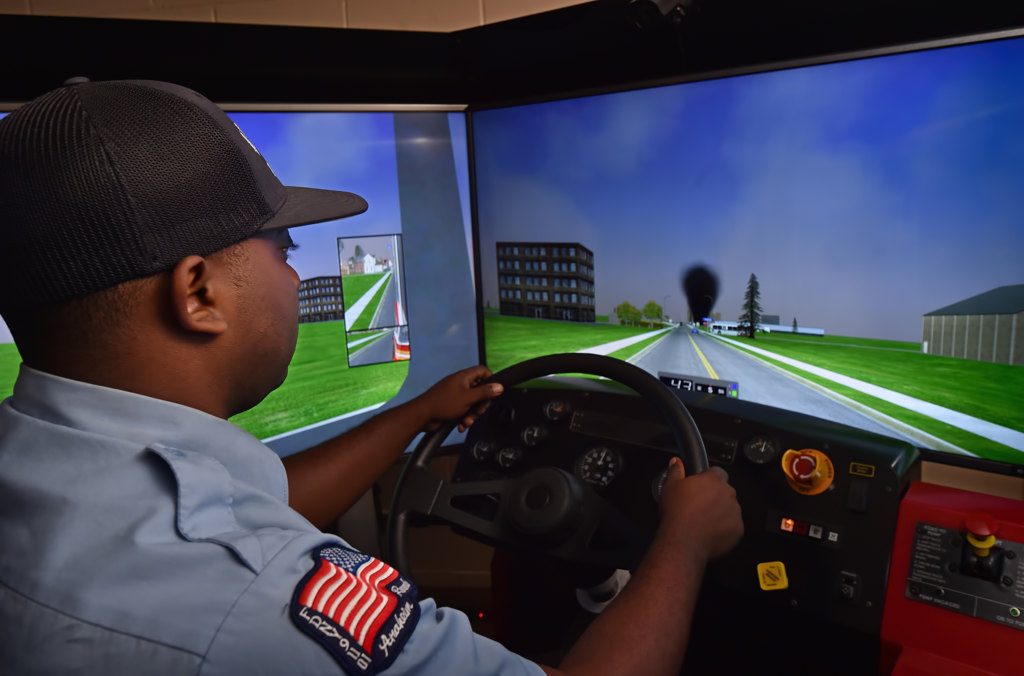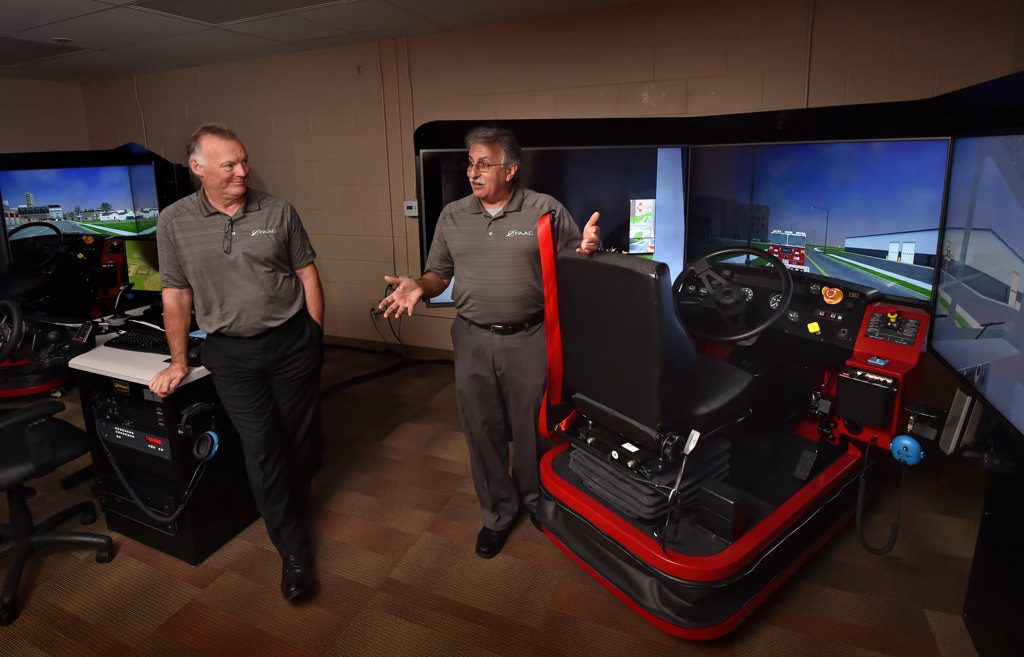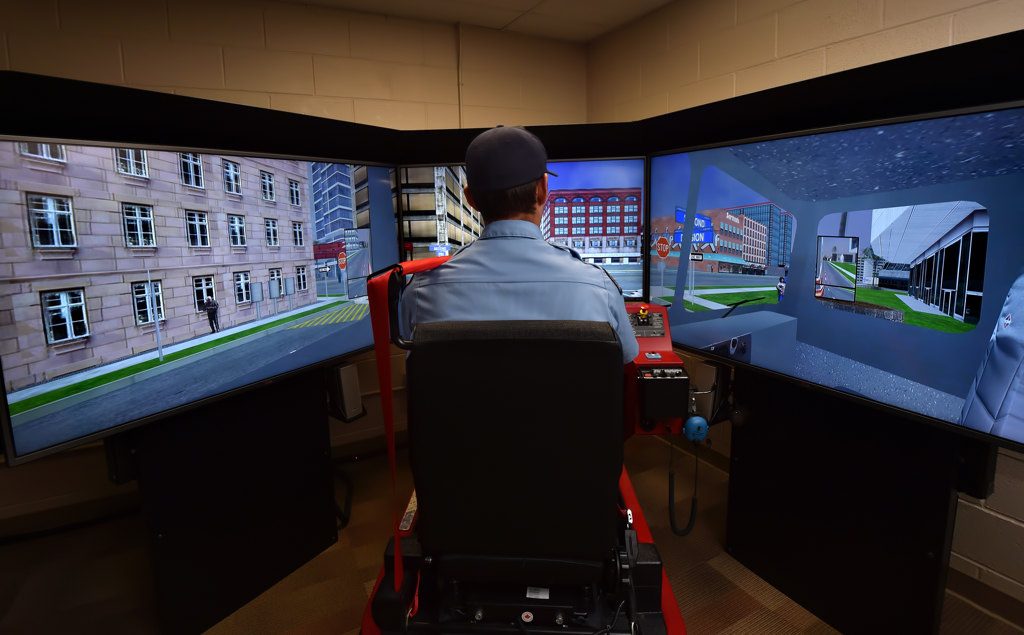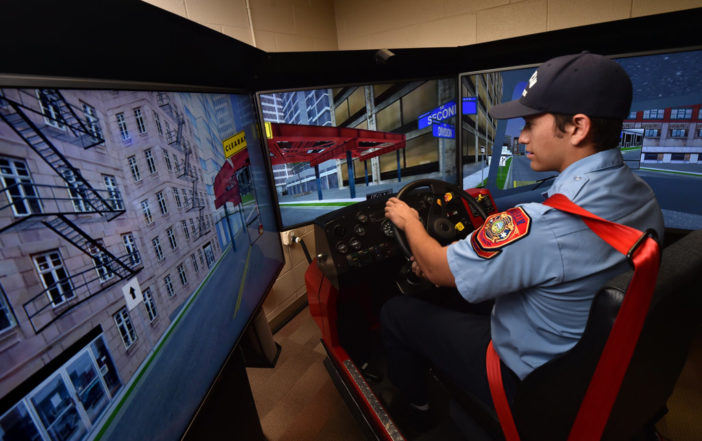Standing in the center console wearing a headset, Robert Raheb guided the two cadets through driving their respective fire trucks.
The first round didn’t go so well – one cadet ended in an accident with injuries and the second “made it through (by) the skin of your teeth,” according to Raheb’s assessment.
But to Raheb, this is just fine. Because this is where the learning happens.
“That’s the importance of how this training works,” Raheb told the cadets as he went over their scenario with them. “The important thing is that you learn from your mistakes.”
Also important is the fact that the mistakes aren’t being made out in the real world using actual fire trucks that could potentially damage property and injure people.

Anaheim Fire & Rescue Cadet Isaiah Turner heads toward the black smoke rising up in the distance as he drives one of Anaheim’s new fire truck/fire engine driver simulators at the North Net Training Authority in Anaheim.
Photo by Steven Georges/Behind the Badge OC
The scenarios were performed using North Net Training Authority in Anaheim’s driving simulators, developed by Michigan-based simulator company FAAC Inc. Raheb and two other FAAC representatives were at North Net June 13-15 for an open house with demonstrations for local fire agencies. Anaheim Fire & Rescue already has been using the driving simulators as part of its training program.
“It’s very intense,” AFR cadet Isaiah Turner said with a laugh, adding that going over his recorded simulation exercise afterward helped open his eyes to what to look out for when driving a fire truck.
Turner was one of several AFR cadets who tested out the simulators during the open house.
“It was definitely a very stressful learning opportunity … trying not to make mistakes,” he said.

Anaheim Fire & Rescue Cadet Isaiah Turner gets a few tips from Paul Becotte, a training specialist with FAAC Inc., as Turner tries out one of Anaheim’s new fire truck/fire engine driver simulators at the North Net Training Authority in Anaheim.
Photo by Steven Georges/Behind the Badge OC
The two driving simulators housed at North Net are set up with large screens, chairs, seat belts and consoles to behave just like a real fire truck would – including the ability to blare sirens and honk a loud horn.
There are more than a hundred available scenarios set up for the simulators, and the company also offers a simulator that allows for creating custom scenarios so that an agency could recreate an actual fire call for training purposes. The simulators also allow for weather, including sleet and snow.
“They can slip on ice,” Raheb said.
Agency instructors can run the training as they see fit – making it easier or more challenging as needed.
“As it unfolds, the instructor can start throwing little foils in,” Raheb said.

Bill Martin, public safety business manager, left, and Robert Raheb, emergency response training specialist, both with FAAC Inc., show off Anaheim’s two new fire truck/fire engine driver simulators located at the North Net Training Authority in Anaheim.
Photo by Steven Georges/Behind the Badge OC
He admitted to doing a little of that when he was speaking to one of the cadets over the radio when the cadet should have been concentrating on clearing an area. He purposely tried to trip the cadet up, Raheb said, to up the challenge in the scenario.
“It allows the student to take the process to completion,” Raheb said. “We allow them to keep going … that’s where they learn.”

Anaheim Fire & Rescue Cadet Jacob Flynn gets a wide peripheral view, including accurate rear-view mirrors, as he drives a simulated fire truck around town.
Photo by Steven Georges/Behind the Badge OC

Paul Becotte, a training specialist with FAAC Inc., explains the controls of Anaheim’s new fire truck/fire engine driver simulators to Anaheim Fire & Rescue Cadet Ennio Mendizabal as he gets practice on handling a fire truck.
Photo by Steven Georges/Behind the Badge OC
 Behind the Badge
Behind the Badge



